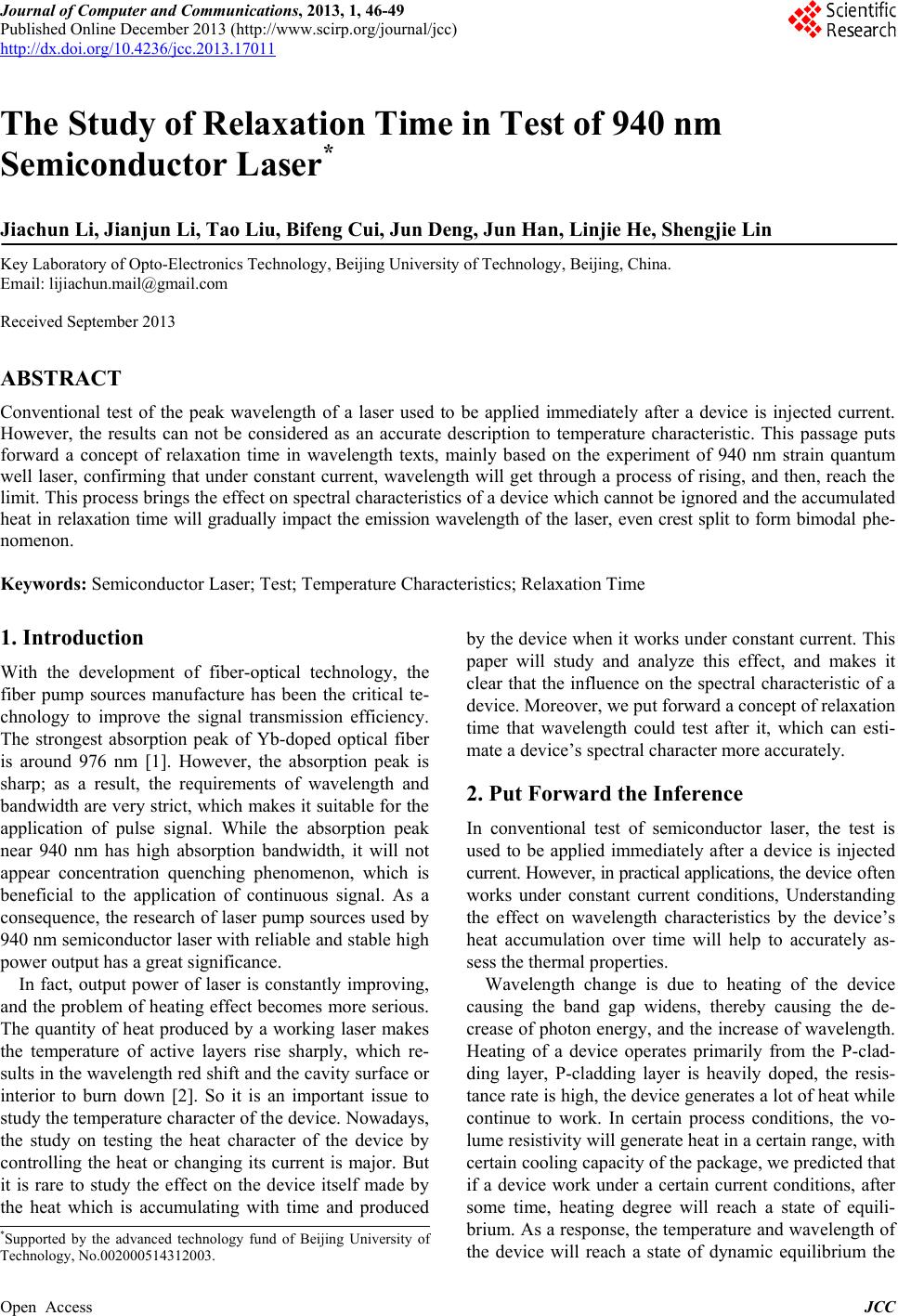
Journal of Computer and Communications, 2013, 1, 46-49
Published Online December 2013 (http://www.scirp.org/journal/jcc)
http://dx.doi.org/10.4236/jcc.2013.17011
Open Access JCC
The Study of Relaxation Time in Test of 940 nm
Semiconductor Laser*
Jiachun Li, Jianjun Li, Tao Liu, Bifeng Cui, Jun Deng, Jun Han, Linjie He, Shengjie Lin
Key Laboratory of Opto-Electronics Technology, Beijing University of Technology, Beijing, China.
Email: lijiachun.mail@gmail.com
Received September 2013
ABSTRACT
Conventional test of the peak wavelength of a laser used to be applied immediately after a device is injected current.
However, the results can not be considered as an accurate description to temperature characteristic. This passage puts
forward a concept of relaxation time in wavelength texts, mainly based on the experiment of 940 nm strain quantum
well laser, confirming that under constant current, wavelength will get through a process of rising, and then, reach the
limit. This process brings th e effect on sp ectral characteristics of a d evice which cannot be ignored and the accumulated
heat in relaxation time will gradually impact the emission wavelength of the laser, even crest split to form bimodal phe-
nomenon.
Keywords: Semiconductor Laser; Test; Temperature Characteristics; Relaxation Time
1. Introduction
With the development of fiber-optical technology, the
fiber pump sources manufacture has been the critical te-
chnology to improve the signal transmission efficiency.
The strongest absorption peak of Yb-doped optical fiber
is around 976 nm [1]. However, the absorption peak is
sharp; as a result, the requirements of wavelength and
bandwidth ar e very strict, which makes it suitable for the
application of pulse signal. While the absorption peak
near 940 nm has high absorption bandwidth, it will not
appear concentration quenching phenomenon, which is
beneficial to the application of continuous signal. As a
consequence, the research of laser pump sources used by
940 nm semiconductor laser with reliable and stable high
power output has a gr e a t signifi c a nc e .
In fact, output power of laser is constantly improving,
and the problem of heating effect becomes more serious.
The quantity of heat produced by a working laser makes
the temperature of active layers rise sharply, which re-
sults in the wavelength red shift and the cavity surface or
interior to burn down [2]. So it is an important issue to
study the temperature character of the device. Nowadays,
the study on testing the heat character of the device by
controlling the heat or changing its current is major. But
it is rare to study the effect on the device itself made by
the heat which is accumulating with time and produced
by the device when it works under constant current. This
paper will study and analyze this effect, and makes it
clear that the influence on the spectral characteristic of a
device. Moreover, we put forward a concept of relaxation
time that wavelength could test after it, which can esti-
mate a device’s spectral character more accurately.
2. Put Forward the Inference
In conventional test of semiconductor laser, the test is
used to be applied immediately after a device is injected
current. However, in practical applications, the device often
works under constant current conditions, Understanding
the effect on wavelength characteristics by the device’s
heat accumulation over time will help to accurately as-
sess the thermal properties.
Wavelength change is due to heating of the device
causing the band gap widens, thereby causing the de-
crease of photon energy, and the increase of wavelength.
Heating of a device operates primarily from the P-clad-
ding layer, P-cladding layer is heavily doped, the resis-
tance rate is high, the device generates a lot of heat while
continue to work. In certain process conditions, the vo-
lume resistivity will generate heat in a certain range, with
certain cooling capacity of the package, we predicted that
if a device work under a certain current conditions, after
some time, heating degree will reach a state of equili-
brium. As a response, the temperature and wavelength of
the device will reach a state of dynamic equilibrium the
*
Supported by the advanced technology fund of Beijing University of
Technology, No.002000514312003.